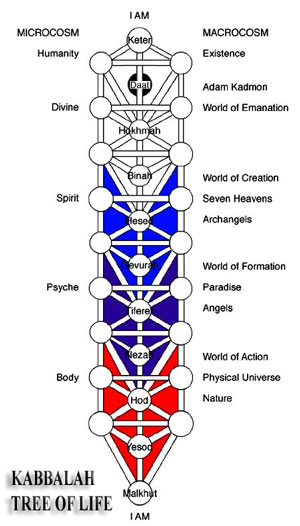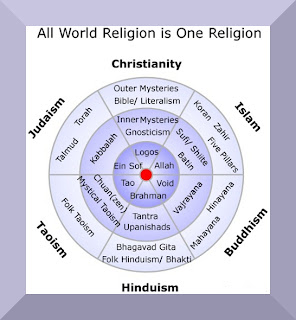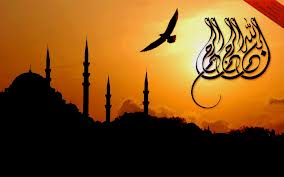Related reading materials on Jewish Mysticism, Kabbalah:

Related reading materials on Islamic Mysticism, Tasawwuf or Sufism:
 Must Read Books on Sufism (online eBooks)
Must Read Books on Sufism (online eBooks) Quick Journey into Realms of Rumi and Sufism
Quick Journey into Realms of Rumi and Sufism
Islamic Mysticism, Sufism & Jewish Mysticism, Kabbalah
by Peter Lamborn Wilson


Introduction to the Sufi Path
Of all the strands of thought, tradition, and belief that make up the Islamic universe, Sufism in its doctrinal aspect stands out as the most intact, the most purely Islamic: the central strand. Opponents of Sufism often charge it with having originated outside Islam, but a close study of the various schools of philosophy and theology, and a comparison with "primordial" Islam as revealed in the Koran and hadith (authentic sayings of the Prophet Muhammad), will vindicate the Sufis' claim of centrality, of strict adherence to the original purity of the Revelation.
In the context of the history of thought, in fact, Sufism - always insisting on a return to the sources of the Tradition - can be seen to have functioned at times as a positive and healthy reaction to the overly rational activity of the philosophers and theologians. For the Sufis, the road to spiritual knowledge - to Certainty - could never be confined to the process of rational or purely intellectual activity, without sapiential knowledge (zawq, "taste") and the direct, immediate experience of the Heart. Truth, they believed, can be sought and found only with one's entire being; nor were they satisfied merely to know this Truth. They insisted on a total identification with it: a "passing away" of the knower in the Known, of subject in the Object of knowledge. Thus, when the fourth/tenth century Sufi Hallaj proclaimed "I am the Truth" (and was martyred for it by the exoteric authorities), he was not violating the "First Pillar" of Islam, the belief in Unity (tawhid), but simply stating the truth from the mouth of the Truth. So the Sufis believe.
This insistence of total involvement in "mystical" realization, and on a participative understanding of religious doctrine, sharply distinguished Sufism from other Islamic schools of thought. In fact, considering themselves the true core of Islam, Sufis appeared as outsiders not only to the philosophers and theologians, but even to "ordinary" Muslims. Their peculiarity, their distinctness, manifested itself in every aspect of their lives: their daily activities, their worship, social relations, and even style or means of expression. Like mystics in all Traditions, they tended to remake language and form for their own purposes, and as in all Traditional civilizations, the potency and directness of their expression tended to flow out and permeate other areas not directly related to mysticism in the narrow sense: literature, the arts and crafts, etc.
Leaving This World Behind
Buddha founded his Path on the human fact of suffering. Islam gives the basic situation in which we find ourselves a slightly different interpretation: man in his ordinary state of consciousness is literally asleep ("and when he dies he wakes," as Mohammad said). He lives in a dream, whether of enjoyment or suffering - a phenomenal, illusory existence. Only his lower self is awake, his "carnal soul." Whether he feels so or not, he is miserable. But potentially the situation can be changed, for ultimately man is not identical with his lower self. (The Prince of Balkh, Ibrahim Adham, lost in the desert while hunting, chased a magic stag, which turned on him and asked, "Were you born for this?") Man's authentic existence is in the Divine; he has a higher Self, which is true; he can attain felicity, even before death ("Die before you die," said the Prophet). The call comes: to flight, migration, a journey beyond the limitations of world and self.
Awakening
Imprisoned in the cage of the world (the world in its negative, "worldly" sense, not in the positive sense of the world-as-icon or Divine Manifestation), man is exiled and forgetful of his true home. To keep his part of the Covenant, to be faithful to his promise, he must set out on the Path from sleep to awakening. It is only the blessed few for whom this Path lasts no longer than a single step, although in theory all that is needed is to "turn around" or "inside out" and be what one is. For most seekers the Path is long; one Sufi speaks of "a thousand and one" different stages.
"Everything perishes save His Face"; the first step on the Path is to begin to contemplate the futility of the world of dust, the world in which one's lower self is doomed. The seeker must renounce it all, including his own self, and seek that which is Everlasting. He must travel from things to Nothing, from existence to Nonexistence.
How does one get lost on purpose? Our present state is one of forgetfulness toward the Divine - the true Self - and remembrance of worldly affairs and the lower self. The cure for this is a reversal: remembrance of the true Self, the Divine within, and forgetfulness toward everything else. In Sufism the basic technique for this is invocation or "remembrance" (zekr) of the Divine Name, which is mysteriously identical with the Divine Being. Through this discipline the fragments of our directionless minds are regathered, our outward impulse turned inward and concentrated. This is the act of a lover who thinks of nothing but his beloved.
Jewish Mysticism, Kabbalah
The Kabbalistic tree of life Mysticism and mystical experiences have been a part of Judaism since the earliest days. The Torah contains many stories of mystical experiences, from visitations by angels to prophetic dreams and visions. The Talmud considers the existence of the soul and when it becomes attached to the body. Jewish tradition tells that the souls of all Jews were in existence at the time of the Giving of the Torah and were present at the time and agreed to the Covenant. There are many stories of places similar to Christian heaven and purgatory, of wandering souls and reincarnation. The Talmud contains vague hints of a mystical school of thought that was taught only to the most advanced students and was not committed to writing. There are several references in ancient sources to ma'aseh bereishit (the work of creation) and ma'aseh merkavah (the work of the chariot [of Ezekiel's vision]), the two primary subjects of mystical thought at the time.
In the middle ages, many of these mystical teachings were committed to writing in books like the Zohar. Many of these writings were asserted to be secret ancient writings or compilations of secret ancient writings.Like most subjects of Jewish belief, the area of mysticism is wide open to personal interpretation. Some traditional Jews take mysticism very seriously. Mysticism is an integral part of Chasidic Judaism, for example, and passages from kabbalistic sources are routinely included in traditional prayer books. Other traditional Jews take mysticism with a grain of salt. One prominent Orthodox Jew, when introducing a speaker on the subject of Jewish mysticism, said basically, "it's nonsense, but it's Jewish nonsense, and the study of anything Jewish, even nonsense, is worthwhile."
The mystical school of thought came to be known as Kabbalah, from the Hebrew root Qof-Bet-Lamed, meaning "to receive, to accept." The word is usually translated as "tradition." In Hebrew, the word does not have any of the dark, sinister, evil connotations that it has developed in English. For example, the English word "cabal" (a secret group of conspirators) is derived from the Hebrew word Kabbalah, but neither the Hebrew word nor the mystical doctrines have any evil implications to Jews.
In Judaism, Kabbalah means literally "what has been handed down", i.e. Tradition. The idea is that just as there is a written scripture or Divine Revelation, the "Revealed Torah (Law)", this being the Pentateuch (the first five books of Moses; i.e. the first five books of the Old Testament; to which were later appended commentaries like the Talmud, Mishnah, and so on), so there is also an inner or "hidden" Torah, a "secret" (sod), which gives the inner meaning of the Torah, and describes the nature of God, creation, the origin of the Cosmos, the nature of man, and so on. It is this Hidden Torah, which is supposedly handed down by word of mouth (although since the twelfth century it has been committed to writing) that constitutes the Kabbalah.
Kabbalah then, is the occult or mystical branch of the religion, the inner or esoteric counterpart to the outer or legalistic doctrine, the Torah or "Law", just as Sufism is the occult and mystical tradition within Islam.
Of all the strands of thought, tradition, and belief that make up the Islamic universe, Sufism in its doctrinal aspect stands out as the most intact, the most purely Islamic: the central strand. Opponents of Sufism often charge it with having originated outside Islam, but a close study of the various schools of philosophy and theology, and a comparison with "primordial" Islam as revealed in the Koran and hadith (authentic sayings of the Prophet Muhammad), will vindicate the Sufis' claim of centrality, of strict adherence to the original purity of the Revelation.
In the context of the history of thought, in fact, Sufism - always insisting on a return to the sources of the Tradition - can be seen to have functioned at times as a positive and healthy reaction to the overly rational activity of the philosophers and theologians. For the Sufis, the road to spiritual knowledge - to Certainty - could never be confined to the process of rational or purely intellectual activity, without sapiential knowledge (zawq, "taste") and the direct, immediate experience of the Heart. Truth, they believed, can be sought and found only with one's entire being; nor were they satisfied merely to know this Truth. They insisted on a total identification with it: a "passing away" of the knower in the Known, of subject in the Object of knowledge. Thus, when the fourth/tenth century Sufi Hallaj proclaimed "I am the Truth" (and was martyred for it by the exoteric authorities), he was not violating the "First Pillar" of Islam, the belief in Unity (tawhid), but simply stating the truth from the mouth of the Truth. So the Sufis believe.
This insistence of total involvement in "mystical" realization, and on a participative understanding of religious doctrine, sharply distinguished Sufism from other Islamic schools of thought. In fact, considering themselves the true core of Islam, Sufis appeared as outsiders not only to the philosophers and theologians, but even to "ordinary" Muslims. Their peculiarity, their distinctness, manifested itself in every aspect of their lives: their daily activities, their worship, social relations, and even style or means of expression. Like mystics in all Traditions, they tended to remake language and form for their own purposes, and as in all Traditional civilizations, the potency and directness of their expression tended to flow out and permeate other areas not directly related to mysticism in the narrow sense: literature, the arts and crafts, etc.
Leaving This World Behind
Buddha founded his Path on the human fact of suffering. Islam gives the basic situation in which we find ourselves a slightly different interpretation: man in his ordinary state of consciousness is literally asleep ("and when he dies he wakes," as Mohammad said). He lives in a dream, whether of enjoyment or suffering - a phenomenal, illusory existence. Only his lower self is awake, his "carnal soul." Whether he feels so or not, he is miserable. But potentially the situation can be changed, for ultimately man is not identical with his lower self. (The Prince of Balkh, Ibrahim Adham, lost in the desert while hunting, chased a magic stag, which turned on him and asked, "Were you born for this?") Man's authentic existence is in the Divine; he has a higher Self, which is true; he can attain felicity, even before death ("Die before you die," said the Prophet). The call comes: to flight, migration, a journey beyond the limitations of world and self.
Awakening
Imprisoned in the cage of the world (the world in its negative, "worldly" sense, not in the positive sense of the world-as-icon or Divine Manifestation), man is exiled and forgetful of his true home. To keep his part of the Covenant, to be faithful to his promise, he must set out on the Path from sleep to awakening. It is only the blessed few for whom this Path lasts no longer than a single step, although in theory all that is needed is to "turn around" or "inside out" and be what one is. For most seekers the Path is long; one Sufi speaks of "a thousand and one" different stages.
"Everything perishes save His Face"; the first step on the Path is to begin to contemplate the futility of the world of dust, the world in which one's lower self is doomed. The seeker must renounce it all, including his own self, and seek that which is Everlasting. He must travel from things to Nothing, from existence to Nonexistence.
How does one get lost on purpose? Our present state is one of forgetfulness toward the Divine - the true Self - and remembrance of worldly affairs and the lower self. The cure for this is a reversal: remembrance of the true Self, the Divine within, and forgetfulness toward everything else. In Sufism the basic technique for this is invocation or "remembrance" (zekr) of the Divine Name, which is mysteriously identical with the Divine Being. Through this discipline the fragments of our directionless minds are regathered, our outward impulse turned inward and concentrated. This is the act of a lover who thinks of nothing but his beloved.
Jewish Mysticism, Kabbalah
In the middle ages, many of these mystical teachings were committed to writing in books like the Zohar. Many of these writings were asserted to be secret ancient writings or compilations of secret ancient writings.Like most subjects of Jewish belief, the area of mysticism is wide open to personal interpretation. Some traditional Jews take mysticism very seriously. Mysticism is an integral part of Chasidic Judaism, for example, and passages from kabbalistic sources are routinely included in traditional prayer books. Other traditional Jews take mysticism with a grain of salt. One prominent Orthodox Jew, when introducing a speaker on the subject of Jewish mysticism, said basically, "it's nonsense, but it's Jewish nonsense, and the study of anything Jewish, even nonsense, is worthwhile."
The mystical school of thought came to be known as Kabbalah, from the Hebrew root Qof-Bet-Lamed, meaning "to receive, to accept." The word is usually translated as "tradition." In Hebrew, the word does not have any of the dark, sinister, evil connotations that it has developed in English. For example, the English word "cabal" (a secret group of conspirators) is derived from the Hebrew word Kabbalah, but neither the Hebrew word nor the mystical doctrines have any evil implications to Jews.
In Judaism, Kabbalah means literally "what has been handed down", i.e. Tradition. The idea is that just as there is a written scripture or Divine Revelation, the "Revealed Torah (Law)", this being the Pentateuch (the first five books of Moses; i.e. the first five books of the Old Testament; to which were later appended commentaries like the Talmud, Mishnah, and so on), so there is also an inner or "hidden" Torah, a "secret" (sod), which gives the inner meaning of the Torah, and describes the nature of God, creation, the origin of the Cosmos, the nature of man, and so on. It is this Hidden Torah, which is supposedly handed down by word of mouth (although since the twelfth century it has been committed to writing) that constitutes the Kabbalah.
Kabbalah then, is the occult or mystical branch of the religion, the inner or esoteric counterpart to the outer or legalistic doctrine, the Torah or "Law", just as Sufism is the occult and mystical tradition within Islam.


























































0 comments:
Post a Comment